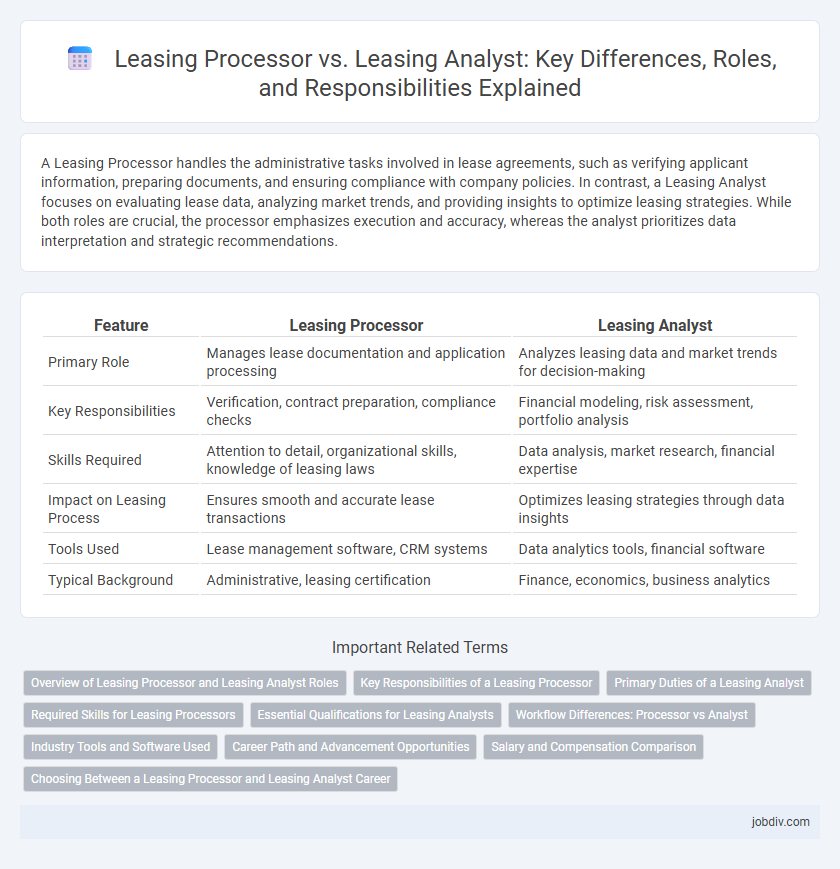A Leasing Processor handles the administrative tasks involved in lease agreements, such as verifying applicant information, preparing documents, and ensuring compliance with company policies. In contrast, a Leasing Analyst focuses on evaluating lease data, analyzing market trends, and providing insights to optimize leasing strategies. While both roles are crucial, the processor emphasizes execution and accuracy, whereas the analyst prioritizes data interpretation and strategic recommendations.
Table of Comparison
| Feature | Leasing Processor | Leasing Analyst |
|---|---|---|
| Primary Role | Manages lease documentation and application processing | Analyzes leasing data and market trends for decision-making |
| Key Responsibilities | Verification, contract preparation, compliance checks | Financial modeling, risk assessment, portfolio analysis |
| Skills Required | Attention to detail, organizational skills, knowledge of leasing laws | Data analysis, market research, financial expertise |
| Impact on Leasing Process | Ensures smooth and accurate lease transactions | Optimizes leasing strategies through data insights |
| Tools Used | Lease management software, CRM systems | Data analytics tools, financial software |
| Typical Background | Administrative, leasing certification | Finance, economics, business analytics |
Overview of Leasing Processor and Leasing Analyst Roles
Leasing Processors manage the administrative tasks involved in lease agreements, including preparing contracts, verifying documentation, and ensuring compliance with company policies. Leasing Analysts focus on evaluating lease data, conducting market research, and analyzing financial metrics to support strategic leasing decisions. Both roles are integral in streamlining leasing operations and optimizing portfolio management.
Key Responsibilities of a Leasing Processor
A Leasing Processor manages lease documentation, ensuring accuracy and compliance with regulatory standards while preparing and organizing contracts for execution. They coordinate with leasing agents, property managers, and clients to facilitate smooth lease processing and resolve any discrepancies. Their role is critical in maintaining efficient workflow and supporting lease approvals through meticulous data entry and verification.
Primary Duties of a Leasing Analyst
Leasing Analysts primarily focus on evaluating lease agreements, performing financial analysis, and ensuring compliance with regulatory standards to support informed decision-making. They analyze market trends, tenant creditworthiness, and lease performance metrics to optimize portfolio profitability. This role requires strong analytical skills to interpret data and provide insights that guide leasing strategy and negotiations.
Required Skills for Leasing Processors
Leasing Processors require strong organizational skills and attention to detail to accurately manage lease documentation and ensure compliance with regulatory standards. Proficiency in property management software and a thorough understanding of leasing laws and tenant screening procedures are essential. Effective communication skills and the ability to coordinate between leasing agents, clients, and legal teams support smooth transaction processing.
Essential Qualifications for Leasing Analysts
Leasing Analysts require strong analytical skills, proficiency in financial modeling, and experience with lease agreement evaluation to assess lease viability and risk accurately. Essential qualifications include a background in real estate finance, familiarity with lease accounting standards like ASC 842 or IFRS 16, and advanced Excel capabilities for detailed data analysis. Unlike Leasing Processors who focus on administrative tasks, Leasing Analysts concentrate on optimizing lease portfolios and supporting strategic decision-making through comprehensive data interpretation.
Workflow Differences: Processor vs Analyst
Leasing processors focus on verifying application details, conducting background checks, and preparing lease documentation to ensure compliance and accuracy before lease execution. Leasing analysts evaluate market trends, rental pricing, and financial data to provide insights that influence leasing strategies and optimize occupancy rates. The processor's workflow centers on transaction execution and administrative tasks, while the analyst's workflow involves data interpretation and decision support for portfolio management.
Industry Tools and Software Used
Leasing Processors primarily utilize property management software such as Yardi, MRI, and Entrata to manage lease documentation, process applications, and coordinate tenant data efficiently. Leasing Analysts focus on advanced data analysis tools like Excel, Power BI, and ARGUS Enterprise to assess lease performance, market trends, and financial forecasting. Both roles increasingly rely on integrated CRM systems and automation platforms to streamline leasing workflows and improve accuracy.
Career Path and Advancement Opportunities
Leasing Processors primarily handle application documentation and verification, serving as entry-level roles that build foundational knowledge in lease administration. Leasing Analysts focus on market trends, financial data, and lease performance, offering a more strategic position that can lead to senior roles in real estate management or investment analysis. Career paths often progress from Leasing Processor to Leasing Analyst, with advancement opportunities expanding toward portfolio management, asset management, or leasing leadership positions.
Salary and Compensation Comparison
Leasing processors typically earn an average salary range between $40,000 and $55,000 annually, focusing on administrative and documentation tasks that support leasing activities. Leasing analysts command higher compensation, often ranging from $55,000 to $75,000 per year, due to their expertise in market analysis, financial modeling, and portfolio performance assessment. Salary variations depend on factors such as geographic location, company size, and individual experience within the real estate leasing industry.
Choosing Between a Leasing Processor and Leasing Analyst Career
Leasing Processors handle administrative tasks such as application review, lease document preparation, and data entry, ensuring smooth transaction flow and compliance with company policies. Leasing Analysts focus on market research, financial analysis, and performance metrics to optimize leasing strategies and maximize revenue. Choosing between a Leasing Processor and Leasing Analyst career depends on preferring operational efficiency roles or analytical, data-driven decision-making positions within the leasing industry.
Leasing Processor vs Leasing Analyst Infographic

 jobdiv.com
jobdiv.com